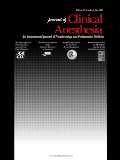
Arthroplasty
Fascia iliaca block offers opioid sparing effect vs PAI in patients undergoing TKA
J Clin Anesth. 2016 Dec;35:404-41071 patients scheduled for total knee arthroplasty were randomized to postoperative analgesia through either a fascia iliaca block or periarticular injection analgesia. Patients were assessed for pain, analgesic consumption, and satisfaction over the first 24 hours postoperatively. Visual analog scale (VAS) pain scores at rest and on movement did not significantly differ between groups at any time point. Patient-controlled analgesia (PCA) morphine consumption was significantly lower in the fascia iliaca block group compared to the periarticular injection analgesia group.
Unlock the full article
Get unlimited access to OrthoEvidence with a free trial
Start TrialCritical appraisals of the latest, high-impact randomized controlled trials and systematic reviews in orthopaedics
Access to OrthoEvidence podcast content, including collaborations with the Journal of Bone and Joint Surgery, interviews with internationally recognized surgeons, and roundtable discussions on orthopaedic news and topics
Subscription to The Pulse, a twice-weekly evidence-based newsletter designed to help you make better clinical decisions
Exclusive access to original content articles, including in-house systematic reviews, and articles on health research methods and hot orthopaedic topics
Or continue reading this full article
Register Now

Subscribe to "The Pulse"
Evidence-Based Orthopaedics direct to your inbox.




































